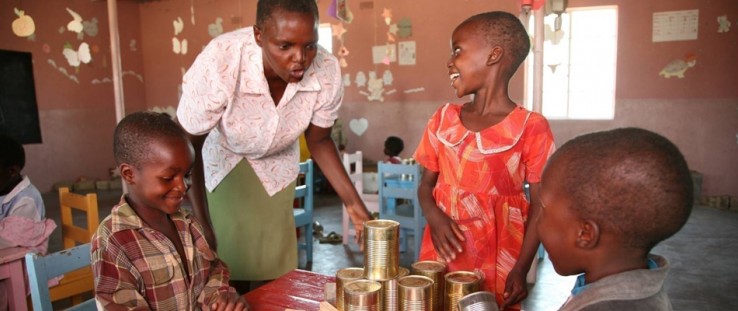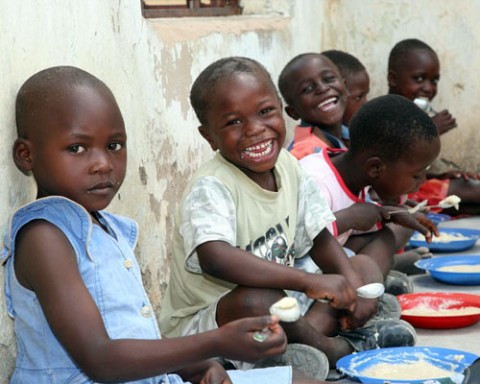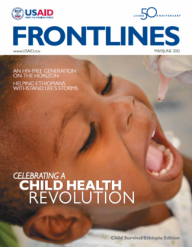 Early childhood development (ECD) programs provide access to important health services, including lifesaving pediatric HIV/AIDS care and nutrition support, as well as legal and protection services and education.
Early childhood development (ECD) programs provide access to important health services, including lifesaving pediatric HIV/AIDS care and nutrition support, as well as legal and protection services and education.
 Early childhood development (ECD) programs provide access to important health services, including lifesaving pediatric HIV/AIDS care and nutrition support, as well as legal and protection services and education.
Early childhood development (ECD) programs provide access to important health services, including lifesaving pediatric HIV/AIDS care and nutrition support, as well as legal and protection services and education.
What if we could create a generation free of HIV, where children around the world have the chance to grow up to lead long, productive and healthy lives?
Over 30 years ago – when scientists first discovered the deadly virus that causes AIDS – addressing the needs of children affected by the disease was an afterthought.
While enormous progress has been made, children are still considered one of the most vulnerable groups, if not the most vulnerable group, affected by HIV and AIDS.
The statistics are overwhelming: Approximately 16.6 million children have lost one or both their parents to AIDS. Over 2.5 million children are living with HIV worldwide – the vast majority in sub-Saharan Africa.
But there’s hope.
Children can flourish in spite of AIDS.
Imagine a girl named Rudo, who loses her mother when she is 1 year old. Her father wants to place Rudo in an orphanage because he can’t care for her on his own. Thanks to support from USAID, Rudo is enrolled in a local early childhood development (ECD) center, where she learns and plays with other children, receives nutritious meals, and has access to critical health services and immunizations. Two years later, Rudo is a healthy, happy 3-year-old with a bright future ahead of her.
What was once a lofty goal to eliminate pediatric AIDS so that children like Rudo can grow up free of HIV and with their families intact, could soon be a reality with investments in low-cost, high-impact pediatric HIV/AIDS programs, including those that focus on early-childhood development – the period of greatest growth and development for children.
Leaders from around the globe are starting to take notice and put children first on their political agendas. In June 2011, the President’s Emergency Plan for AIDS Relief (PEPFAR) and the Joint United Nations Program on HIV/AIDS (UNAIDS) launched a global plan to eliminate new HIV infections among children by 2015. And, late last year, President Barack Obama and Secretary of State Hillary Rodham Clinton made children living with HIV a priority by calling for an AIDS-free generation – a milestone that has since put us at the tipping point in our fight against HIV/AIDS worldwide.
This type of political leadership and commitment to the disease is a major step to eliminating pediatric AIDS in our lifetime.
Through PEPFAR, USAID – a lead implementer of PEPFAR-funded programs – is working with partners to support children affected by HIV/AIDS. To date, USAID and PEPFAR have provided services to nearly 4 million children orphaned and made vulnerable by AIDS.
Early Support for the Most Vulnerable
According to Roxana Rogers, director of the Office of HIV/AIDS at USAID, reaching the youngest children orphaned and made vulnerable by AIDS is at the forefront of the Agency’s efforts. Early childhood development (ECD) programs offer one solution. ECD services provide access to important health services, including lifesaving pediatric HIV/AIDS care and nutrition support, as well as essential legal and protection services and early education.
ECD programs are also a smart investment: They provide cost-effective services that make long-term economic sense – and result in significant gains in public health, development and education for the most vulnerable children.
Children orphaned and made vulnerable by AIDS as well as those living with HIV are at particular risk during early childhood, where malnourishment, unsafe living environments, and weak relationships with adults or caregivers can stunt growth and hamper development.
However, ECD services focus on creating a safe environment for young children and providing proper nutrition, medical care, and the consistent presence of stable, caring adults. ECD services also help reduce infant and child mortality, grade repetition, future criminal activity, drug abuse, teen pregnancy, and dependence on social services.
These programs can take a variety of forms. Centers offer child care, nutritious meals, health screening, and opportunities for young children to safely explore and learn about their environment. Home-visiting programs target new parents, monitor milestones, and ensure that parents and caregivers are able to access other essential services.
Through either approach, ECD programs can significantly decrease the impact of poverty, social inequality, gender discrimination and HIV, while helping educate and encourage caregivers. Expanding Treatment
Children under 5 are at high risk of specific health problems and infectious diseases, including HIV. Without treatment, half of all HIV-positive children will die before their second birthday. Yet, the majority of HIV-positive children who need treatment don’t actually receive it.
ECD programs can help identify young children most at risk of HIV infection, prevent mother-to-child transmission, and ensure that children infected by the disease receive necessary care and treatment.
Proper nutrition is another significant challenge for children affected by AIDS. HIV-positive children need additional food in order for their AIDS medicines to be effective. ECD services can help by providing nutritional supplements as well as training in sustainable farming and gardening techniques for youth and caregivers.
ECD programs are a great example of successful health service integration. By addressing children’s health, nutrition, and cognitive and physical development in a variety of settings, ECD services provide more comprehensive care to young children and their families.
For example, during regular check-ups at local health centers, also called well-baby visits, integrated services can help teach parents ways to stimulate their children’s learning through songs and games.
As part of prenatal and antenatal care, trained birth attendants can also help families to complete birth certificates and register their children in the health system, while health-care workers can conduct medical screenings at schools or ECD centers.
We have an opportunity to eliminate pediatric AIDS and ensure that children are born free of HIV – but only if we work together and focus our efforts on scaling up successful programs like early-childhood development and other services that support children orphaned and made vulnerable by AIDS.
Only then can we achieve what Secretary Clinton recently described as the greatest gift the U.S. could give our collective future: the creation of an AIDS-free generation.
*Maury Mendenhall, technical adviser for orphans and vulnerable children in the Office of HIV/AIDS, contributed to this article.

Helping Vulnerable Children in Zimbabwe
Early childhood development services are a main focus of J.F. Kapnek Trust, a USAID-supported organization that helps orphans and vulnerable children by providing the social, economic and health services they need to thrive. Focusing on training and expanding the capacity of health-care workers to prevent new HIV infections in children, J.F. Kapnek Trust provided approximately 200,000 HIV-positive pregnant women with services to prevent HIV transmission to their babies in the last year. The organization also works to improve preschool education by supporting classroom renovations and trainings for teachers, while placing emphasis on children with special needs.
In Zimbabwe, the work of J.F. Kapnek Trust led to a rapid scale up of ECD programs over the past three years and the establishment of thousands of new preschool classes for young children, and the development of new pediatric AIDS programs. Approximately 1.2 million people are living with HIV in Zimbabwe. Of those, 150,000 are children under the age of 15.









Comment
Make a general inquiry or suggest an improvement.